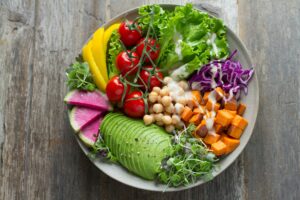What is a Balanced Diet And do You Eat That Way?
A balanced diet is easy to find in books and rarely on the table. Although nutrients are abundantly scattered throughout the food we eat, soil depletion, storage, food processing, and cooking destroy many of them. However, there are enough of them left so balancing the meal makes sense. After all, vitamin supplements cannot work without food, and the better food you eat, the more effective your vitamin supplements will be. Unfortunately, it is unlikely that the demands of today’s society in terms of nutrition will be met with a “balanced” diet.

Regardless, to know whether you are balancing your diet or not, you should familiarize yourself with the four basic food groups and the recommended number of portions that should be eaten from them every day. Portion sizes should be determined individually; smaller quantities for less active people, and larger quantities for young people engaged more physically.
Milk Group:
Milk, cheese, yogurt, dishes made from milk.
- 3 portions per day for a child
- 4 servings per day for young people
- 2 servings per day for adults
- 4 servings per day for pregnant and lactating women
Meat Group:
Beef, veal, pork, lamb, fish, poultry, liver, or eggs.
Dry peas, beans, soy extenders, and nuts combined with animal proteins – including eggs, milk, and cheese – or proteins from cereals can replace a portion of meat.
- 2 servings a day
- 3 servings per day for pregnant women
Group Fruit-Vegetable:
Lemon or other fruit rich in vitamin C (or tomato juice) should be eaten daily. Dark green, leafy, or yellow vegetables and fruits should be eaten three to four times a week for vitamin A.
- 4 servings a day
Group Cereal:
Integral or enriched cereals, bread in all forms, hot or cold cereals, macaroni, noodles, or other dough.
- 4 servings a day
The recommended portions, as pointed out by the National Research Council, are designed to provide 1,200 calories. You are expected to adjust the portion size to suit your individual height, weight, and energy needs.














Post Comment